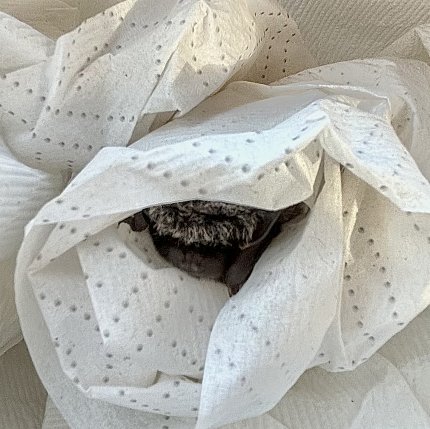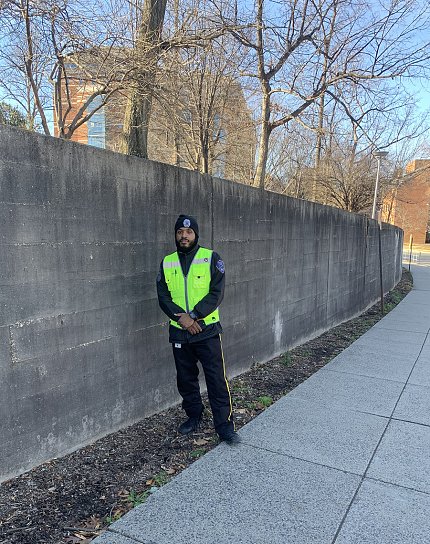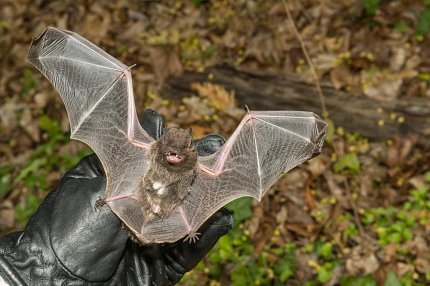NIH Goes Batty

Photo: Theresa Engels/NHLBI
It was early morning on Dec. 5 when a woman noticed a small grey bat clinging to the retaining wall on the NIH campus, near the visitor entrance. She’d seen it in that exact spot the day before. This time, she reported the bat’s presence to NIH security at the nearby vehicle entrance.
Security Officer Eric Crutchfield’s response made a big difference to the tiny creature. He called the NIH Police non-emergency number to notify the Wildlife Veterinary Volunteers (WVV), an NIH Intramural Research Program partnership led by Dr. Tom Thomas, a veterinarian in the Office of Research Services, Division of Veterinary Resources. Volunteers address wildlife concerns around the Bethesda campus.
“I got the notification around 9:30 a.m., but I couldn’t get to the bat right away,” said Dr. Ginger Tansey, the WVV veterinarian on call. “While I was preparing to go find the bat, I took a moment to look up the Maryland [Department of Natural Resources] website to confirm what we could do for this bat. The DNR page has a search function for wildlife rehabilitation specialists, who are federally and state-licensed professionals. It was important for me to find out who would be able to accept this bat, if it needed care. [Then] I called Second Chance Wildlife Center (SCWC), [a nonprofit that rehabilitates injured wild animals], and confirmed with them. Now, I could go rescue this bat, carefully.”

Photo: Ginger Tansey/NEI
Tansey then met Crutchfield at the gate and assessed the bat gripped to the wall.
“I could see the bat was slow, minimally responsive and its respiratory rate was very low,” recounted Tansey. “This suggested hypothermia, and it was in the shade of a cold cement wall, so it could have been accidentally trapped in a cycle of hypothermia. I carefully grasped it by the scruff and wrapped it in a disposable paper towel with a hand-warmer.”
Crutchfield was an eager observer. “This is the closest I’ve ever been to a bat,” he said.
Tansey then placed the bat “burrito” into an NIH-approved animal transport box.
NHLBI veterinary technician Theresa Engels volunteered to deliver “Batman” to Second Chance. She said she has taken orphaned or injured wildlife to SCWC many times over the years.
On Dec. 13, the wildlife center shared the news that the bat had recovered and had been released three days earlier, when the ambient temperature was above 60˚F, which would allow the Silver-Haired Bat time to find a safe roost before temperatures dropped again.
“She looked like a young (possibly first-year) bat that likely picked a bad place to roost and got caught out in the cold,” said Hannah Wilson, SCWC clinic manager. “Activity and flight become difficult for them, if not impossible, when temperatures drop.

Photo: Jay Ondreicka/Shuttershock
“Once we determined she was healthy, we waited for a warmer day to release her again so she could find a more appropriate hibernaculum for the winter,” Wilson explained. “We get many bats in throughout the winter for the same reason (getting caught out in the cold and poor-roosting choices), or because their hibernaculums are destroyed by people. Once we get into the colder months, we often have to overwinter any bats that come in, as it won’t get warm enough for them to fly again until spring. This bat got lucky and likely caught the last warm day of the season.”
Tansey agreed. “I’m glad to have played a part in rescuing this little bat, and I hope she has a long and healthy life.”
Engels said, “I have always had a soft spot for bats. I think they are really cute. I am glad I could help, and very happy that our little bat was healthy and able to be released back into the wild.”
